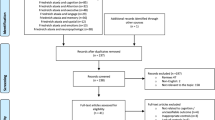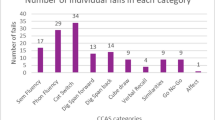Abstract
Friedreich ataxia (FRDA) is an autosomal recessive neurodegenerative disorder with subtle impact on cognition. Inhibitory processes and cognitive flexibility were examined in FRDA by assessing the ability to suppress a predictable verbal response. We administered the Hayling Sentence Completion Test (HSCT), the Trail Making Test, and the Stroop Test to 43 individuals with FRDA and 42 gender- and age-matched control participants. There were no significant group differences in performance on the Stroop or Trail Making Test whereas significant impairment in cognitive flexibility including the ability to predict and inhibit a pre-potent response as measured in the HSCT was evident in individuals with FRDA. These deficits did not correlate with clinical characteristics of FRDA (age of disease onset, disease duration, number of guanine-adenine-adenine repeats on the shorter or larger FXN allele, or Friedreich Ataxia Rating Scale score), suggesting that such impairment may not be related to the disease process in a straightforward way. The observed specific impairment of inhibition and predictive capacity in individuals with FRDA on the HSCT task, in the absence of impairment in associated executive functions, supports cerebellar dysfunction in conjunction with disturbance to cortico-thalamo-cerebellar connectivity, perhaps via inability to access frontal areas necessary for successful task completion.
Similar content being viewed by others
References
Pandolfo M. Friedreich ataxia: the clinical picture. J Neurol. 2009;256:3–8.
Delatycki MB, Corben LA. Clinical features of Friedreich ataxia. J Child Neurol. 2012;27(9):1133–7.
Delatycki MB, Williamson R, Forrest SM. Friedreich ataxia: an overview. J Med Genet. 2000;37
Cossée M, Dürr A, Schmitt M, Dahl N, Trouillas P, Allinson P, et al. Friedreich’s ataxia: point mutations and clinical presentation of compound heterozygotes. Ann Neurol. 1999;45(2):200–6.
Koeppen AH, Mazurkiewicz JE. Friedreich ataxia: neuropathology revised. J Neuropath Exp Neurol. 2013;72(2):78–90.
Koeppen AH, Davis AN, Morral JA. The cerebellar component of Friedreich’s ataxia. Acta Neuropath. 2011;122(3):323–30.
Mascalchi M. The cerebellum looks normal in Friedreich ataxia. Am J Neuroradiol. 2013;34(2):E22.
Stefanescu MR, Dohnalek M, Maderwald S, Thurling M, Minnerop M, Beck A, et al. Structural and functional MRI abnormalities of cerebellar cortex and nuclei in SCA3, SCA6 and Friedreich’s ataxia. Brain. 2015;138(Pt 5):1182–97.
Manto M, Lorivel T. Cognitive repercussions of hereditary cerebellar disorders. Cortex. 2011;47(1):81–100.
Schmahmann JD. Disorders of the cerebellum: ataxia, dysmetria of thought, and the cerebellar cognitive affective syndrome. J Neuropsy Clin Neurosci. 2004;16(3):367–78.
Timmann D, Drepper J, Frings M, Maschke M, Richter S, Gerwig M, et al. The human cerebellum contributes to motor, emotional and cognitive associative learning. A review Cortex. 2010;46(7):845–57.
de Nóbrega E, Nieto A, Barrosso J, Montón F. Differential impairment in semantic, phonemic, and action fluency performance in Friedreich’s ataxia: possible evidence of prefrontal dysfunction. J Int Neuropsych Soc. 2007;13:944–52.
Klopper F, Delatycki MB, Corben LA, Bradshaw JL, Rance G, Georgiou-Karistianis N. The test of everyday attention reveals significant sustained volitional attention and working memory deficits in Friedreich ataxia. J Int Neuropsych Soc. 2011;17:196–200.
Nieto A, Correia R, de Nóbrega E, Montón F, Hess S, Barroso J. Cognition in Friedreich ataxia. Cerebellum. 2012;11(4):834–44.
Nachbauer W, Bodner T, Boesch S, Karner E, Eigentler A, Neier L, et al. Friedreich ataxia: executive control is related to disease onset and GAA repeat length. Cerebellum. 2014;13(1):9–16.
Corben LA, Akhlaghi H, Georgiou-Karistianis N, Bradshaw JL, Egan GF, Storey E, et al. Impaired inhibition of prepotent motor tendencies in Friedreich ataxia demonstrated by the Simon interference task. Brain Cog. 2011;76(1):140–5.
Corben LA, Delatycki MB, Bradshaw JL, Horne MK, Fahey MC, Churchyard AC, et al. Impairment in motor reprogramming in Friedreich ataxia reflecting possible cerebellar dysfunction. J Neurol. 2010;257(5):782–91.
Akhlaghi H, Corben L, Georgiou-Karistianis N, Bradshaw J, Storey E, Delatycki MB, et al. Superior cerebellar peduncle atrophy in Friedreich’s ataxia correlates with disease symptoms. Cerebellum. 2011;10(1):81–7.
Della Nave R, Ginestroni A, Giannelli M, Tessa C, Salvatore E, Salvi F, et al. Brain structural damage in Friedreich’s ataxia. J Neurol Neurosurg Psych. 2008;79:82–5.
Akhlaghi H, Yu J, Corben L, Georgiou-Karistianis N, Bradshaw JL, Storey E, et al. Cognitive deficits in Friedreich ataxia correlate with micro-structural changes in dentatorubral tract. Cerebellum. 2014;13(2):187–98.
Clemm von Hohenberg C, Schocke MF, Wigand MC, Nachbauer W, Guttmann CR, Kubicki M, et al. Radial diffusivity in the cerebellar peduncles correlates with clinical severity in Friedreich ataxia. Neurol Sci. 2013;34(8):1459–62.
Corben LA, Kashuk SR, Akhlaghi H, Jamadar S, Delatycki MB, Fielding J, et al. Myelin paucity of the superior cerebellar peduncle in individuals with Friedreich ataxia: an MRI magnetization transfer imaging study. J Neurol Sci. 2014;343(1–2):138–43.
Della Nave R, Ginestroni A, Tessa C, Salvatore E, Bartolomei I, Salvi F, et al. Brain white matter tracts degeneration in Friedreich ataxia. An in vivo MRI study using tract-based spatial statistics and voxel-based morphometry. Neurolmage. 2008;40(1):19–35.
Egger K, Clemm von Hohenberg C, Schocke MF, Guttmann CR, Wassermann D, Wigand MC, et al. White matter changes in patients with Friedreich ataxia after treatment with erythropoietin. J Neuroimag. 2014;24(5):504–8.
Zalesky A, Akhlaghi H, Corben LA, Bradshaw JL, Delatycki MB, Storey E, et al. Cerebello-cerebral connectivity deficits in Friedreich ataxia. Brain Struc Func. 2014;219(3):969–81.
Vieira Karuta SC, Raskin S, de Carvalho NA, Gasparetto EL, Doring T, Teive HA. Diffusion tensor imaging and tract-based spatial statistics analysis in Friedreich’s ataxia patients. Park Rel Dis. 2015;21(5):504–8.
Akhlaghi H, Corben L, Georgiou-Karistianis N, Bradshaw J, Delatycki MB, Storey E, et al. A functional MRI study of motor dysfunction in Friedreich’s ataxia. Brain Res. 2012;1471:138–54.
Georgiou-Karistianis N, Akhlaghi H, Corben LA, Delatycki MB, Storey E, Bradshaw JL, et al. Decreased functional brain activation in Friedreich ataxia using the Simon effect task. Brain Cog. 2012;79:200–8.
Ginestroni A, Diciotti S, Cecchi P, Pesaresi I, Tessa C, Giannelli M, et al. Neurodegeneration in Friedreich’s ataxia is associated with a mixed activation pattern of the brain. A fMRI study. Hum Brain Map. 2012;33(8):1780–91.
Keren-Happuch E, Chen SH, Ho MH, Desmond JE. A meta-analysis of cerebellar contributions to higher cognition from PET and fMRI studies. Hum Brain Map. 2014;35(2):593–615.
Bellebaum C, Daum I. Cerebellar involvement in executive control. Cerebellum. 2007;6(3):184–92.
Moberget T, Gullesen EH, Andersson S, Ivry RB, Endestad T. Generalized role for the cerebellum in encoding internal models: evidence from semantic processing. J Neurosci. 2014;34(8):2871–8.
Mantovan MC, Martinuzzi A, Squarzanti F, Bolla A, Silvestri I, Liessi G, et al. Exploring mental status in Friedreich’s ataxia: a combined neuropsychological, behavioural and neuroimaging study. Eur J Neurol. 2006;13:827–35.
White M, Lalonde R, Botez-Marquard T. Neuropsychologic and neuropsychiatric characteristics of patients with Friedreich’s ataxia. Acta Neur Scand. 2000;102(4):222–6.
Corben LA, Georgiou-Karistianis N, Bradshaw JL, Hocking DR, Churchyard AJ, Delatycki MB. The Fitts task reveals impairments in planning and online control of movement in Friedreich ataxia: reduced cerebellar-cortico connectivity? Neuroscience. 2011;192:382–90.
Corben LA, Delatycki MB, Bradshaw JL, Churchyard AJ, Georgiou-Karistianis N. Utilization of advance motor information is impaired in Friedreich ataxia. Cerebellum. 2011;10(4):793–803.
Wollmann T, Barroso J, Monton F, Nieto A. Neuropsychological test performance of patients with Friedreich’s ataxia. J Clin Exp Neuropsych. 2002;24(5):677–86.
Burgess P, Shallice T. Response suppression, initiation and strategy use following frontal lobe lesions. Neuropsychologia. 1996;34(4):263–72.
Burgess P, & Shallice T, Inventors; Thames Valley Test Company Limited, assignee. The Hayling and Brixton Tests- Manual. Bury St Edmonds, England: 1997.
Golden CJ. Stroop color and word test. A manual for clinical and experimental uses. Illinois: Stoelting; 2002.
Reitan MN. The relation of the trail making test to organic brain damage. J Consult Psych. 1955;19(5):393–4.
Subramony SH, May W, Lynch D, Gomez C, Fischbeck K, Hallett M, et al. Measuring Friedreich ataxia: interrater reliability of a neurologic rating scale. Neurology. 2005;64(7):1261–2.
Nelson HE, Wilson J. National Adult Reading Test (NART). Windsor: NFER-Nelson; 1991.
Dogan I, Tinnemann E, Romanzetti S, Mirzazade S, Costa AS, Werner CJ, et al. Cognition in Friedreich’s ataxia: a behavioral and multimodal imaging study. Ann Clin Trans Neurol. 2016;1-16
Sanchez-Cubillo I, Perianez JA, Adrover-Roig D, Rodriguez-Sanchez JM, Rios-Lago M, Tirapu J, et al. Construct validity of the Trail Making Test: role of task-switching, working memory, inhibition/interference control, and visuomotor abilities. J Int Neuropsych Soc. 2009;15(3):438–50.
Stroop JR. Studies of interference in serial verbal reactions. J Exp Psych. 1935;18:633–62.
Collette F, Van der Linden M, Delfiore G, Degueldre C, Luxen A, Salmon E. The functional anatomy of inhibition processes investigated with the Hayling task. NeuroImage. 2001;14(2):258–67.
Moberget T, Ivry RB. Cerebellar contributions to motor control and language comprehension: searching for common computational principles. Ann New York Acad Sci. 2016;1369(1):154–71.
Chuderski A, Smolen T. An integrated utility-based model of conflict evaluation and resolution in the Stroop task. Psych Rev. 2016;123(3):255–90.
Corben LA, Georgiou-Karistianis N, Fahey MC, Storey E, Churchyard A, Horne MK, et al. Towards an understanding of cognitive function in Friedreich ataxia. Brain Res Bull. 2006;70:197–202.
Ciancarelli I, Cofini V, Carolei A. Evaluation of neuropsychological functions in patients with Friedreich ataxia before and after cognitive therapy. Func Neurol. 2010;25(2):81–5.
França AE, D’Abreu A, Yasuda CL, Bonadia LC, Santos da Silva M, Nucci A, et al. A combined voxel-based morphometry and 1H-MRS study in patients with Friedreich’s ataxia. J Neurol. 2009;256:1114–20.
Georgiou-Karistianis N, Akhlaghi H, Corben LA, Delatycki MB, Storey E, Bradshaw JL, et al. Decreased functional brain activation in Friedreich ataxia using the Simon effect task. Brain Cog. 2012;79(3):200–8.
Acknowledgements
We thank the participants who so willingly gave their time and continued to support our research. Funding was received from the Friedreich Ataxia Research Association (Australasia) and the Friedreich Ataxia Research Alliance (USA). This work was supported by the Victorian State Government Operational Infrastructure Support and Australian Government NHMRC IRIISS.
Author information
Authors and Affiliations
Corresponding author
Ethics declarations
Study approval was obtained from the Monash Health and Monash University Human Research Ethics Committees (ref no: 04052C). All participants gave their informed, written consent in accordance with the Declaration of Helsinki.
Conflict of Interest
The authors declare that they have no conflict of interest.
Rights and permissions
About this article
Cite this article
Corben, L.A., Klopper, F., Stagnitti, M. et al. Measuring Inhibition and Cognitive Flexibility in Friedreich Ataxia. Cerebellum 16, 757–763 (2017). https://doi.org/10.1007/s12311-017-0848-7
Published:
Issue Date:
DOI: https://doi.org/10.1007/s12311-017-0848-7




